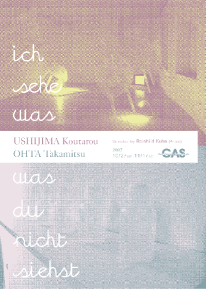Exhibition "Ich sehe was, was du nicht siehst"

Selected by Reinhild Kuhn(Artist)
Open: Mon.-Sat. 1:00pm-7:00pm
(Close: 29 Oct., 7-9 Nov., Sun. and National Holidays)
- Opening reception: Sat,27 Oct., 18:00-(500Yen with one drink)
- Artist Talk: Sat,17 Nov., 16:00- (500Yen)
Having entered a room together with other people and, after having left, asking what each one has seen, one thing will soon become obvious: There are things that have been perceived by all spectators as well as things only one or a few of them have noticed. Every single observer has been scanning the room in a n individual way and with differing results. Perception is always accompanied by selection. Additionally, viewing patterns and experiences make us rely on earlier perceptions and keep us from being totally attentive and seeing what is actually there.
The german children’s game, "Ich sehe was, was du nicht siehst"(?I see something you can’t see“ or "I spy with may little eye, something beginning with ...), increases the viewing attention by simple means. The rules are quite easy to learn: A child chooses a certain object from his or her surrounding and then tells the others about the chosen objetc's colour, for instance: ?I can see something you can’t see and that is ... red!“ Immediately all players will start to scan the environment for red objects in order to identify the chosen one. All at once the players will see much more red objects in the surrounding than before. The first to call out loud and name the correct object will win and then will be the one to start the next round. The children view has become detail-focused, experiencing the unnoticed.
We have chosen the title "Ich sehe was, was du nicht siehst" (" I see something, you can't see" ), because the artists Ushijima Koutarou and Takamitsu Ohta are working to enhance our attention, too. They are not dealing with the obvious world. In contrary they want to sensitize us to hidden phenomena and emotions, albeit showing different artistic attitudes. Ushijima Koutarou creates emotional situations. He is not mainly interested in superficial emotions. In his work he deals with emotions affecting our moods in a more subtle way. The artist does not want to directly convey his emotions to the public. He creates situations and environments in which we may follow his observations and stories in order to compare to our own life and experiences.
Takamitsu Ohta directs one's attention to everyday's objects and phenomena. By a process of transformation, he makes things visible that everyone knows of, but doesn't pay particular attention to in daily life. Although we easily understand the actual technical background, he offers us amazingly poetic moments while seeing his interpretation of the world.
Reinhild Kuhn (Artist)